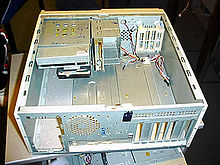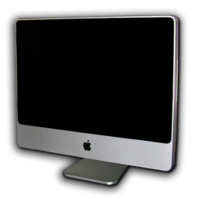- Computer case
-
A stripped ATX desktop case. The motherboard will lie flat on the bottom, against the right panel, with peripheral connectors protruding through the rear panel, drive bays at the top and front, and the power supply at the top and rear.

A computer case (also known as a computer chassis, cabinet, box, tower, enclosure, housing, system unit or simply case) is the enclosure that contains most of the components of a computer (usually excluding the display, keyboard and mouse). A computer case is sometimes incorrectly referred to metonymously as a CPU or hard drive referring to components housed within the case. CPU was a more common term in the earlier days of home computers, when peripherals other than the motherboard were usually housed in their own separate cases.
Cases are usually constructed from steel (often SECC — Steel, Electrogalvanized, Cold rolled, Coil) or aluminium. Plastic is sometimes used, and other materials such as wood and even Lego blocks have appeared in home-built cases.
Contents
Sizes
Cases can come in many different sizes (known as form factors). The size and shape of a computer case is usually determined by the form factor of the motherboard, since it is the largest component of most computers. Consequently, personal computer form factors typically specify only the internal dimensions and layout of the case. Form factors for rack-mounted and blade servers may include precise external dimensions as well, since these cases must themselves fit in specific enclosures.
For example, a case designed for an ATX motherboard and power supply may take on several external forms, such as a vertical tower (designed to sit on the floor, height > width) or a flat desktop (height < width) or pizza box (height ≤ 2 inches, designed to sit on the desk under the computer's monitor). Full-size tower cases are typically larger in volume than desktop cases, with more room for drive bays and expansion slots. Desktop cases—and mini-tower cases designed for the reduced microATX form factor—are popular in business environments where space is at a premium.[1]
Currently, the most popular form factor for desktop computers is ATX, although microATX and small form factors have also become very popular for a variety of uses. Companies like In Win Development, Shuttle Inc. and AOpen have popularized small cases, for which FlexATX is the most common[dubious ] motherboard size. Apple Inc. has also produced the Mac Mini computer, which is similar in size to a standard CD-ROM drive.
Tower cases come in mini-tower, mid-tower, and big-tower/full-tower sizes. Full tower cases are typically 22 inches or more in height and intended to stand on the floor. They have anywhere from six to ten externally accessible drive bays, with more bays only internally accessible. The ratio of external to internal bays is shifting, however, as computing technology moves from floppy disks and CD-ROMs to large capacity hard drives, USB flash drives, and network-based solutions. Midtower cases are smaller, about 18" high with two to four external bays. A minitower case will typically have only one or two external bays and stand from 14" to 16" tall.
Layout
Computer cases usually include sheet metal enclosures for a power supply unit and drive bays, as well as a rear panel that can accommodate peripheral connectors protruding from the motherboard and expansion slots. Most cases also have a power button or switch, a reset button, and LEDs to indicate power status as well as hard drive and network activity. Some cases include built-in I/O ports (such as USB and headphone ports) on the front of the case. Such a case will also include the wires needed to connect these ports, switches and indicators to the motherboard.
Major component locations
- The motherboard is usually screwed to the case along its largest face, which could be the bottom or the side of the case depending on the form factor and orientation.
- Form factors such as ATX provide a back panel with cut-out holes to expose I/O ports provided by integrated peripherals, as well as expansion slots which may optionally expose additional ports provided by expansion cards.
- The power supply unit is often housed at the top rear of the case; it is usually attached with four screws to support its weight.
- Most cases include drive bays on the front of the case; a typical ATX case includes both 5.25" and 3.5" bays. In modern computers, the former are used mainly for optical drives, while the latter are used for hard drives, floppy drives, and card readers.
- Buttons and LEDs are typically located on the front of the case; some cases include additional I/O ports, temperature and/or processor speed monitors in the same area.
- Vents are often found on the front, back, and sometimes on the side of the case to allow cooling fans to be mounted via surrounding threaded screw holes.
Internal access
Tower cases have either a single side panel which may be removed in order to access the internal components or a large cover that saddles the chassis. Traditionally, most computer cases required screws to hold components and panels in place (i.e. motherboard, PSU, drives, and expansion cards). Recently[when?] there is a trend toward "screwless" cases, in which components are held together with snap-in plastic rails, thumbscrews, and other methods that do not require tools; this facilitates quick assembly and modification of computer hardware.
Appearance
Through the 1990s, most computer cases had simple rectangular shapes, and were often painted beige or white with little attention given to visual design. Beige box designs are still found on a large number of budget computers assembled from generic components. This class of machines is still known as white box computers.
Case modding is the artistic styling of computer cases, often to draw attention to the use of advanced or unusual components. Since the early 2000s, some cases have included clear side panels or acrylic windows so that users can look inside while it is operating. Modded cases may also include internal lighting, custom paint, or liquid cooling systems. Some hobbyists build custom cases from raw materials like aluminum, steel, styrofoam, acrylic, or wood.
Case manufacturers
Prominent after-market case manufacturers include Ahanix, AeroCool, Antec, AOpen, Asus, Chenbro, Chieftec, Ci Design, Cooler Master, Ever Case, Foxconn, Gigabyte Technology, HEC Compucase, In Win Development, IXIUM, Lian Li, Lin Chi, CIRCLE, FRONTECH, ODYSSEY, ZEBRONICS, NZXT, OrigenAE, Raidmax, Shuttle Inc., SilverStone Technology, Thermaltake, Xclio, Yue Lin, and Zalman.
Intrusion detection
Some computer cases include a biased switch (push-button) which connects to the motherboard. When the case is opened, the switch position changes and the system records this change. The system's firmware or BIOS may be configured to report this event the next time it is powered on.
This physical intrusion detection system may help computer owners detect tampering with their computer. However, most such systems are quite simple in construction; a knowledgeable intruder can open the case or modify its contents without triggering the switch.
Gallery
- Computer cases
-
Gigabyte Technology 3D Mercury Full-Tower ATX Chassis.
-
A black mid or midi tower case (ATX form factor)
-
A beige mini tower case (microATX form factor)
-
Three of the Wikimedia servers in 1U rackmount cases
-
Enthusiast case featuring translucent panel casemod
-
Antec Fusion V2 home theater PC case with VFD display, volume control and some ports on front.
See also
References
External links
Basic computer components Input devices Keyboard · Image scanner · Microphone · Pointing device (Graphics tablet · Joystick · Light pen · Mouse · Touchpad · Touchscreen · Trackball) · Webcam (Softcam)Output devices Removable data storage Computer case Central processing unit (CPU) · Hard disk / Solid-state drive · Motherboard · Network interface controller · Power supply · Random-access memory (RAM) · Sound card · Video cardData ports Ethernet · Firewire (IEEE 1394) · Parallel port · Serial port · Thunderbolt · Universal Serial Bus (USB)Categories:- Computer enclosure
Wikimedia Foundation. 2010.










